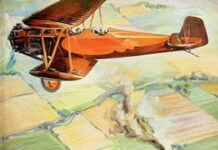The First World War to-end-all-wars continued to fail to live up to its name in 1923. The old animosities continued. The United States and Britain kept replenishing their reserves, while Germany built military aircraft in surrogate countries, and Japan stretched its naval aircraft wings.
But there were lighter moments too, as air passenger travel literally began to take off, mainly in small airplanes but with a few larger, luxurious aircraft. The dream to fly high in the sky with the birds was not over though, as a few interesting, one-person civilian airplanes emerged. Racing aircraft continued to break speed barriers.
JANUARY 1923
Aviator Joseph Sadi-Lecointe sets a new air speed record, averaging 208 mph at Istres, France in a Nieuport NiD 41.
A Spanish Cierva C.4 piloted by Alejandro Gomez Spencer makes the first flight by an autogyro, and the first stable flight by any form of rotary-wing aircraft.
The Cierva C.4 flies a 2.5 mile circuit at Cuatro Vientos airfield in Spain, after previously using autorotation to land without damage.
American Curtiss P-1 Hawk Biplane Pursuit Aircraft
The Curtiss P-1 Hawk biplane pursuit, was an open-cockpit fighter of the United States Army Air Corps,that developed from the earlier PW-8 version. The prototype first flew in January 1923, whereafter 202 were built in various versions.
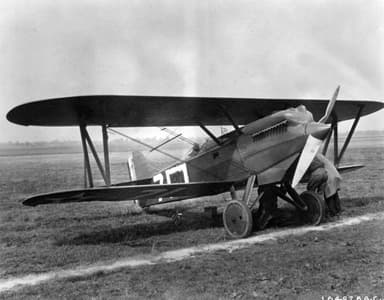
https://en.wikipedia.org/wiki/File:PW-8_aircraft.jpg
The designation PW stood for pursuit, water-cooled aircraft. This particular version was born out of the R-6 racer by the Boeing Corporation, although it was not an unmitigated improvement. It served in a variety of peacetime roles. Each successive variant was heavier, and therefore a little slower.
The specification of the P-1C version delivered during 1927 to 1928 was as follows:
- Length 23 ft, height 8.5 ft, wing span 31.5 ft, wing area 252 sq ft
- Empty weight 2,195 lb, gross weight 2,973 lb, crew one
- Curtiss D-12C (Curtiss V-1150-3) V-12 water-cooled piston engine, 422 hp
- Max 154 mph, cruise 123 mph, range 300 mi, ceiling 21,800 ft, climb 1,460 ft / min
- Two 0.30 inch fixed forward-firing M1919 Browning machine guns
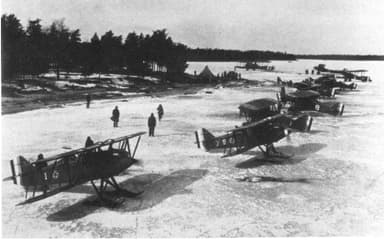
https://commons.wikimedia.org/w/index.php?search=curtiss+PW8&title=Special%3ASearch&profile=advanced&fulltext=1&advancedSearch-current=%7B%7D&ns0=1&ns6=1&ns12=1&ns14=1&ns100=1&ns106=1#/media/File:PW-8s_1st_Pursuit_Group.jpg
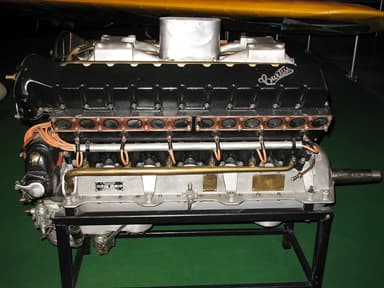
https://en.wikipedia.org/wiki/Curtiss_D-12#/media/File:Curtiss_D-12_2.jpg
Japanese Mitsubishi B1M Biplane Torpedo Bomber
The Mitsubishi B1M ‘Tateku’ – also known as the Navy Type 13 Carrier-Borne Attack Aircraft – first flew in January 1923, served in the Japanese navy and army, and saw action in China. Mitsubishi built a total 443 of various versions, including a light bomber and a converted civilian airplane.
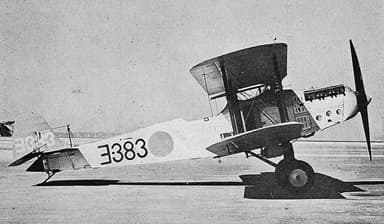
https://en.wikipedia.org/wiki/File:13sikikankou.jpg
British aircraft engineer Herbert Smith designed the prototype while working for Mitsubishi. The aircraft continued in service in various versions through to the mid-1930’s. However, from 1929 onwards a number of surplus aircraft converted to civilian use, after fitting out with enclosed cabins for passengers or cargo.
The specification of the 2MT2 version was as follows:
- Length 32 ft, height 11.5 ft, wing span 48.5 ft, wing area 640 sq ft
- Empty weight 1,442 lb, max take off weight 2,697 lb, crew two
- Napier Lion W-12 water-cooled piston engine, 500 hp
- Max speed 130 mph, endurance 2.6 hrs, service ceiling 14,800 ft
- Two fixed, forward-firing 0.30 inch machine guns
- Two pivoted 0.30 inch machine guns in rear cockpit
- One 18-inch torpedo OR 2 by 529 pound bombs
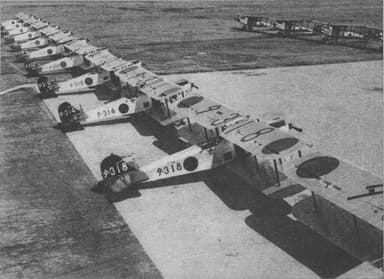
http://1.bp.blogspot.com/-T127hN7IoSo/U0vUGJLAhiI/AAAAAAAAI4Q/nGmljVMIzQk/s1600/TateyamaB1M.jpg
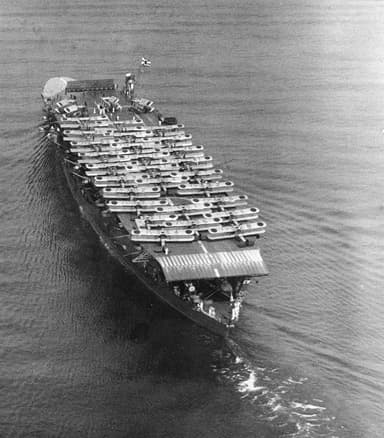
https://www.wikiwand.com/en/Imperial_Japanese_Navy_Air_Service
FEBRUARY 1923
French aviator Joseph Sadi-Lecointe sets a new world air speed record, averaging 234 mph in a Nieuport-Delage airplane at Paris, France.
MARCH 1923
Imperial Japanese Navy Lieutenant Shunichi Kira lands a Mitsubishi 1MF fighter on the aircraft carrier Hōshō, becoming the first Japanese pilot to land on a moving vessel.
Czechoslovakian Aero A.18 Biplane Fighter Aircraft
The Aero A.18 was a continuation of the Ae 02 and Ae 04 fighters Aero had designed during World War I. However, it also borrowed ideas from the more recent A.11 reconnaissance bomber design. Some 20 were built after the first flight in March 1923. And these remained in service until the German invasion in 1939.

https://en.wikipedia.org/wiki/File:Aero_A.18.jpg
The Aero A.18 continued with many characteristics from World War 1 designs. Accordingly, it had an open-air cockpit, mixed construction materials, and fixed undercarriage. Although it had a semi-enclosed engine, and ailerons integrated with its wing tips.
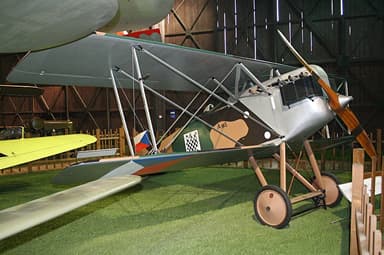
https://commons.wikimedia.org/wiki/File:Replica_Aero_A.18_-_A.18.5_(8236063044).jpg
The specification of the Aero A.18 was as follows:
- Length 19.5 ft, height 9.5 ft, wing span 25 ft, wing area 171 sq ft
- Empty weight 1,404 lb, gross weight 1,900 lb, crew one
- BMW IIIa 6-cyl. water-cooled in-line piston engine, 185 hp
- Max speed 142 mph, range 250 mi, ceiling 30,000 ft, climb 1,930 ft / min
- Armament: Two 0.303 inch Vickers machine-guns
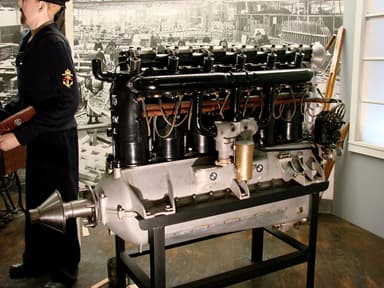
https://en.wikipedia.org/wiki/BMW_IIIa#/media/File:BMW_IIIa.jpg
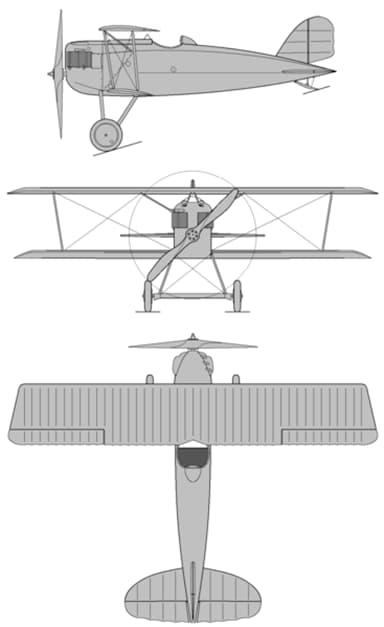
https://en.wikipedia.org/wiki/File:MMK_3VIEWS_Aero_A-18.webp
British Hawker Woodcock Single-Seat Biplane Fighter
The Hawker Woodcock was the first fighter airplane Hawker Engineering Company built, after it succeeded Sopwith Aviation. Some 77 were made after the first flight in March 1923. The Royal Airforce used most of these as night fighters. However, 15 were also supplied to Denmark.
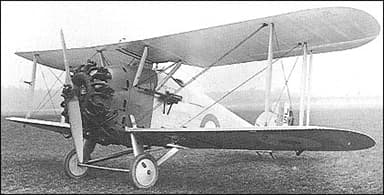
https://en.wikipedia.org/wiki/File:Hawker_woodcock-2.jpg
The original prototype handled badly. However, a fairly major redesign corrected these difficulties, and the Mark II, designated the Woodcock, was judged a success. A number of accidents occurred during early service; however, these too were corrected by the end of 1925.
The specification of the Hawker Woodcock Mk II was as follows:
- Length 25.5 ft, height 9 ft, wing span 34.5 ft, wing area 356 sq ft
- Empty weight 2,014 lb, gross weight 2,979 lb, crew one
- Bristol Jupiter IV 9-cylinder radial engine, 425 hp
- Max 141 mph, cruise 103 mph, range 280 mi, ceiling 22,500 ft, 8 min to 10,000 ft
- Two 0.303 inch Vickers machine guns on sides of fuselage

https://commons.wikimedia.org/w/index.php?search=Hawker+Woodcock&title=Special%3ASearch&go=Go&ns0=1&ns6=1&ns12=1&ns14=1&ns100=1&ns106=1#/media/File:Hawker_Woodcock_II.jpg
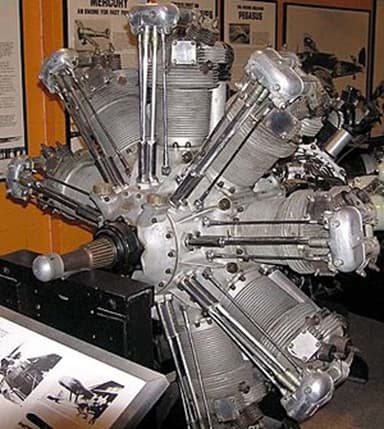
https://en.wikipedia.org/wiki/Bristol_Jupiter#/media/File:Jupiter.engine.arp.750pix.jpg
APRIL 1923
Daimler Airways begins the first scheduled airline service between London and Berlin via Bremen and Hamburg, using ten-passenger de Havilland DH.34’s.
United States Army Air Service Lieutenants John Arthur Macready and Oakley G. Kelly establish a new endurance record, staying aloft for 36 hours 5 minutes in a Fokker T-2, covering a distance of 2,518 miles.
MAY 1923
Belgian airline SABENA forms, and adds new European routes to Syndicat National d’Etude des Transports Aériens’s links that it takes over in Belgian Congo.
British Armstrong Whitworth Siskin Single-Seat Biplane Fighter
The Armstrong Whitworth Siskin was the first Royal Air Force all-metal fighter, and one of the first new British fighters to enter service following the end of the First World War.
It proved successful during its first flight in May, 1923, although the ABC Dragonfly radial engine disappointed. However, the Air Ministry promptly placed an order after switching to the superior Armstrong Siddeley Jaguar motor.
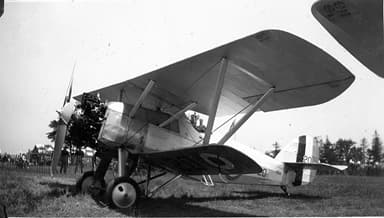
https://commons.wikimedia.org/wiki/File:RCAF_Armstrong-Whitworth_Siskin_IIIA_20_Camp_Borden,_Ontario.jpg
The Armstrong Whitworth Siskin was a response to an Air Ministry request for an all-metal single-seat high performance landplane using the ABC Dragonfly radial engine. The government hoped to make use of the automobile industry when shifting from wood to metal construction.
Armstrong Whitworth produced 483 of the aircraft for delivery in Britain, and to Canada, Estonia and Sweden. Pilots appreciated them for their maneuverability, although they were ‘slightly slow’. The more capable Bristol Bulldog superseded them in October 1932, when they were showing signs of aging.
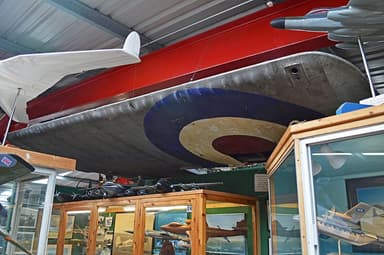
https://commons.wikimedia.org/wiki/File:Armstrong_Whitworth_Siskin_IIIA_upper_wing_(23146488583).jpg
The specification of the Armstrong Whitworth Siskin IIIA was as follows:
- Length 25.5 ft, height 10 ft, wing span 33 ft, wing area 293 sq ft
- Empty weight 2,061 lb, max take-off weight 3,012 lb, crew one
- Armstrong Siddeley Jaguar IV 14-cylinder radial piston engine, 385 hp
- Max speed 156 mph, range 280 mi, ceiling 2,953 ft, 7 minutes to 10,000ft
- Two 0.303 inch Vickers machine guns, up to four 20 lb bombs under-wing
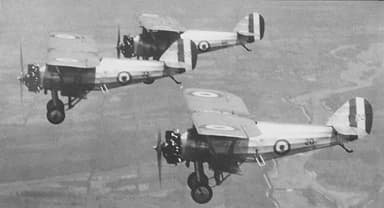
https://en.wikipedia.org/wiki/Armstrong_Whitworth_Siskin#/media/File:RCAF_Siskins_aerobatic_team.jpg
British Gloster Grebe Modified Fighter Trainer Biplane
The Gloster Grebe was a modified Gloster Grouse, an experimental aircraft with a thick, high-lift section upper wing. And a thinner, medium-lift lower wing, with the intention of combining high lift for take-off with low drag. The new version first flew in May 1923, and went on to become popular among Royal Airforce pilots.
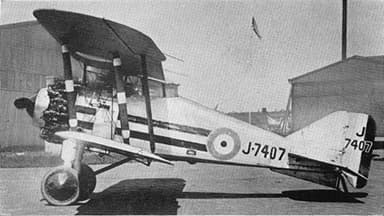
https://en.wikipedia.org/wiki/File:Gloster_Grebe.jpg
The Gloster Grebe was a single-seat, single-engine biplane of fabric-covered wood construction. The fuselage had ash longerons, and spruce stringers joined to plywood formers. While the single-bay wings – which had a considerable overhang outboard of the struts – had fabric-covered spruce spars and ribs.
The Gloster Aircraft Company produced 133 Grebes in total. Of these, 108 were single seaters, while the balance were dual-seat trainers. The aircraft mainly went to the Royal Air Force, with a few going to New Zealand. Britain retired hers in 1929 in favor of the Gloster Gamecock.
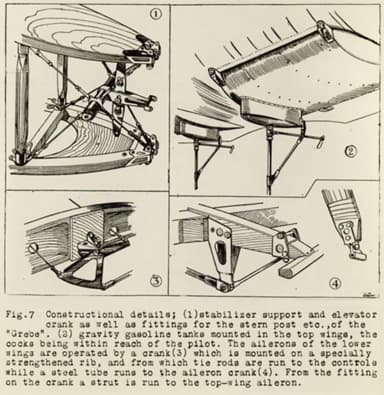
https://commons.wikimedia.org/wiki/File:Gloster_Grebe,Grouse_detail_drawings_2_NACA_Aircraft_Circular_No.7.png
The specification of the Gloster Grebe Mk.II was as follows:
- Length 20 ft, height 9 ft, wing span 29.5 ft, wing area 254 sq ft
- Empty weight 1,720 lb, gross weight 2,614 lb, crew one
- Armstrong Siddeley Jaguar IV 14-cylinder air-cooled radial engine, 400 hp
- Max speed 152 mph, endurance 2.75 hrs, ceiling 23,000 ft, climb 20,000 ft / 23 min
- Armament :Two 0.303 inch Vickers machine guns

https://en.wikipedia.org/wiki/Gloster_Grebe#/media/File:Gloster_Grebe_II_3_view_NACA_Aircraft_Circular_No.7.png
French Blériot 115 Biplane Airliner
The Blériot 115 was a large airliner for its time, mounting one pair of engines on the upper wing, and one pair on the lower one. It first flew on May 9, 1923 successfully. However, the prototype crashed a month later on June 23 killing the pilot, and largely destroying the aircraft.
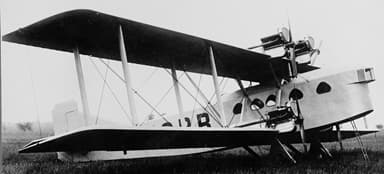
https://en.wikipedia.org/wiki/File:Bl%C3%A9riot_Bl-115_prototype_F-ESBB_right_front_-_Ans_05338-02-094-AL-FL_(tight_crop,_white_balance,_grayscale).jpg
Manufacturer Blériot responded with a refined version of the airplane, the Blériot 115-bis. This first flew a year later in June 1924. The aircraft is perhaps best remembered for the role the third and fourth machines played in attempting to create air routes between France and Africa.
The project ended unfortunately on February 7 1925, when the fourth machine crashed in the Niamey District of Niger, after traveling 2,571 miles. The accident killed its navigator and seriously injured its two pilots, bringing great hopes to an untimely end.

https://commons.wikimedia.org/wiki/File:Le_Bourget.jpg
The specification of the Blériot 115 was as follows:
- Length 47.5 ft, height 16 ft, wing span 82 ft, wing area 1,360 sq ft
- Empty weight 6,504 lb, gross weight 10,803 lb, three crew, eight passengers
- Four Hispano-Suiza 8Ac V-8 water-cooled piston engines, 180 hp each
- Max speed 110 mph, range 370 mi, service ceiling 20,000 ft

https://www.flickr.com/photos/varese2002/24447225962
JUNE 1923
The United States Army Air Service demonstrates an aerial refueling system using two Airco DH.4 aircraft. The system employs a hose with an on/off nozzle and large funnels.
American Boeing Model 15 Open-Cockpit Biplane Fighter
The prototype Boeing Model 15 went on to see duty with the U.S. Army Air Service (as the PW-9 Series) and with the U.S. Navy as a carrier-based fighter (as the FB Series). The design was based on the German Fokker D.VII, of which 142 were brought back to the U.S. for evaluation as part of the Armistice Agreement ending World War I.
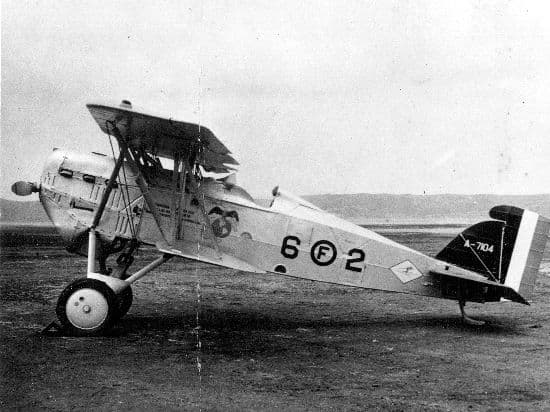
https://en.wikipedia.org/wiki/File:Boeing_FB-5(2).jpg
The American FB-5 fuselage was welded steel tubing braced with piano wire, while the tapered single bay wings were fabric on timber frames. Wing struts were changed from wood (normally used in Boeing designs) to streamlined steel tubes. The landing gear flowed into a small lower wing.
The original 300 hp Wright-Hispano engine was substituted by the 435 hp liquid-cooled Curtiss D-12 when this became available. The first flight took place in June, 1923. However deliveries only commenced in October 1925, whereafter Boeing delivered a total 158 aircraft.

https://en.wikipedia.org/wiki/File:Boeing_FB-5.jpg
The specification of the Army Air Boeing PW-9 version was as follows:
- Length 23.5 ft, height 8 ft, wing span 32 ft, wing area 260 sq ft
- Empty weight 1,936 lb, gross weight 3,120 lb, crew one
- Max speed 159 mph, cruise 142 mph, range 390 mi, climb 1,630 ft / min
- Curtiss D-12 water-cooled V12-cylinder engine, 435 hp
- Two fixed .30 inch machine guns. One, 244 lb bomb load
Russian Junkers T.21 Biplane Reconnaissance Aircraft
The Junkers (JU) T.21 biplane was a reconnaissance aircraft designed in Germany, but manufactured at the Junkers plant at Fili, Russia for use by the Soviet Air Force. It first flew on June 12 1923, whereafter 120 aircraft of several variants were used by Soviet and Iranian air forces.

https://www.armedconflicts.com/Junkers-T-21-t102817
The specification of the Junkers (JU) T.21 was as follows:
- Length 26 ft, height 11.5 ft, wing span 35 ft, wing area 235 sq ft
- Empty weight 1,830 lb, gross weight 2,700 lb, pilot and observer
- BMW IIIa inline six-cylinder SOHC valve train, water-cooled engine
- Max speed 135 mph, cruise 115 mph, range 470 mi, ceiling 18,373 ft

https://en.wikipedia.org/wiki/File:BMW_IIIa.jpg
JULY 1923
American Gerhardt Cycleplane – First Human-Powered Aircraft
The Gerhardt Cycleplane went down in history as a bit of a joke. After all, who would have wanted to power themselves into the sky, when there were so many petrol-driven aircraft on the market?
However, the carbon aircraft economy played a significant contribution to global warming in the century that followed. And so, the Cycleplane deserves its moment in the personal history of flight, as it might possibly have been.

https://en.wikipedia.org/wiki/File:Gerhardt-Cycleplane.jpg
The first flight took place in July 1923. Aerospace engineer William Frederick Gerhardt designed the contraption with even, narrow vertically mounted wings. Two of these attached to the small wood-and-fabric fuselage, while the other five stacked above it to a height of nearly 15 feet.
The Cycleplane first took to the air after an automobile towed, and then released it. Later, it achieved a short hop of 20 feet while two-foot in the air. However, a 1923 news reel depicted its seven wings collapsing while the aircraft was being pushed on the ground. The fuselage tipped over and the aircraft came to rest on its side.
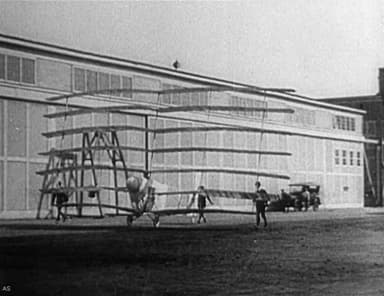
http://www.impdb.org/index.php?title=Category:Gerhardt_Cycleplane
French Farman F.121 Multi-Engine Sesquiplane
The Farman F.121 was part of a family of multi-engine airliners and bombers of the 1920s. The passenger version made its first showing at the 1923 Grand Prix des Avions de Transports expo. The Jabiru, as popularly known, was a fixed-undercarriage sesquiplane powered by two, three or four engines, depending on the variant.

https://en.wikipedia.org/wiki/File:Farman_F.121_photo_NACA_Aircraft_Circular_No.15.png
The aircraft featured unusually stubby, lower sesquiplane wings compensated by oversize upper ones. Although criticized as belonging on lists of ugliest aircraft, it attracted orders from French and Danish airlines after winning the 500,000 franc first prize at the expo. And it boasted first rate passenger accommodation with generous seating in wicker chairs.
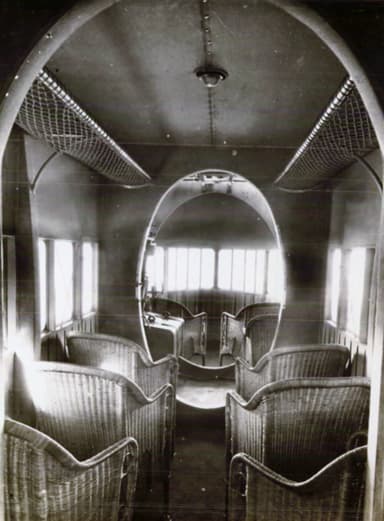
https://en.wikipedia.org/wiki/File:Farman_F.121_interior_photo_NACA_Aircraft_Circular_No.15.png
The specification of the Farman F.121 was as follows:
- Length 45.5 ft, height 14.5 ft, wing span 64.5 ft, wing area 870 sq ft
- Empty weight 7,505 lb, gross 11,508 lb, two crew, 12 to 19 passengers
- Four Hispano-Suiza 8Ac V-8 water-cooled piston engines, 180 hp each
- Max speed 130 mph, cruise 109 mph, range 470 mi, ceiling 13,940 ft
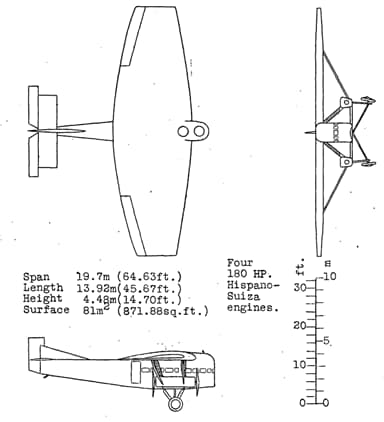
https://en.wikipedia.org/wiki/Farman_F.120#/media/File:Farman_F.121_3_view_NACA_Aircraft_Circular_No.15.png
American Loering OL Amphibian Observation Biplane
The Loering OL Amphibian served in the United States Army Air Corps, the United States Navy and the United States Coastguard. Despite its unusual appearance it was quite successful, with 165 aircraft sold from 1924 onwards.
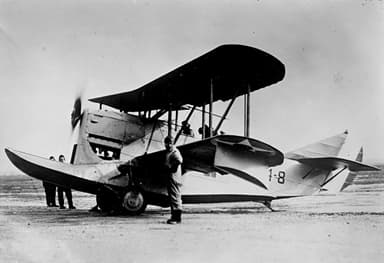
https://en.wikipedia.org/wiki/File:Loening_OL.jpg
The Loering OL Amphibian was a high-performance seaplane with a large single hull, and stabilizing floats fitted underneath each lower wing. The crew in the tandem open cockpit was able to retract the undercarriage with a hand crank. They could choose between wheel control in the forward compartment, or use a joystick from the rear one.
The Amphibian had a duralumin fuselage over a wooden frame. The hull section featured five watertight compartments connected through a selector switch to a bilge pump in the rear cockpit. The engine was encased to protect it from sea spray, and featured a fire suppression sprinkler system.
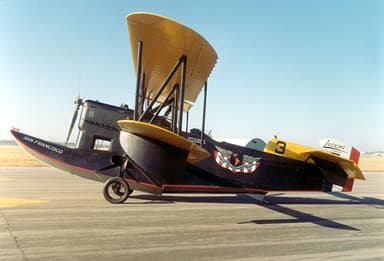
https://commons.wikimedia.org/wiki/File:Loening_OA-1A_USAF.jpg
The specification of the Loering OL-9 Amphibian was as follows:
- Length 34.5 ft, height 12.5 ft, wing span 45 ft, wing area 504 sq ft
- Empty weight 3,649 lb, gross weight 5,404 lb, crew two
- Pratt & Whitney R-1340-4 Wasp air-cooled radial piston engine , 450 hp
- Max speed 122 mph, range 626 mi, service ceiling 14,300 ft
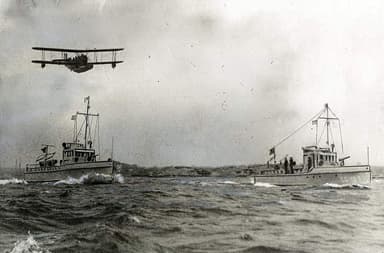
https://commons.wikimedia.org/wiki/File:USCG_Loening_OL-5L_Seaplane_and_Two_75-foot_Patrol_Boats.jpg
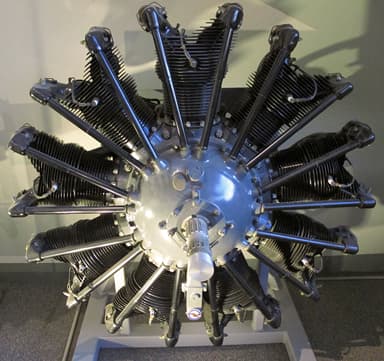
https://en.wikipedia.org/wiki/Pratt_%26_Whitney_R-1340_Wasp#/media/File:Pratt_and_Whitney_Wasp.jpg
AUGUST 1923
The first electric airway beacons start appearing at airfields in the United States to assist in night flying operations.
United States Army Air Service Lieutenant John Richter and Lowell Smith establish a new endurance record of 37 hours 15 minutes in an Airco DH.4. They cover 3,293 miles after being refueled fifteen times during the flight.
British de Havilland DH.50 Four Passenger Transport Biplane
The de Havilland DH.50 was a large, single-engine passenger transport biplane. The company also licensed it for manufacture in Australia, Belgium, and Czechoslovakia. The idea arose when Geoffrey de Havilland realized repurposed war surplus aircraft would need replacing. His idea was so successful the prototype won a prize for reliability a few days after the test flight.
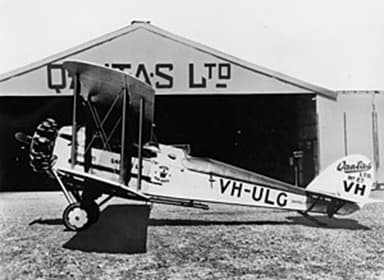
https://en.wikipedia.org/wiki/File:De_Havilland_DH.50J_VH-ULG_Hippomenes_of_Qantas_at_Longreach.jpg
De Havilland produced 17 of the four-passenger, cabin airplanes in Britain. An early version won the King’s Cup Race averaging 106 mph. Another flew 16,000 miles from Croydon Airport, London to Cape Town between November 1925 and February 1926.
Later the same year a de Havilland DH.50 with float gear flew from England to Australia. There, two crew members undertook a three-month, 10,000 mile round trip survey from Point Cook, Victoria to the Pacific Islands. Eighteen were later built in Australia and proved popular in the decade that followed.
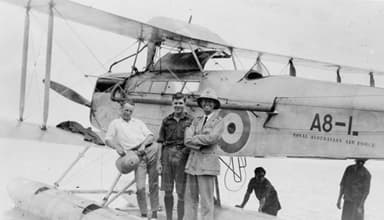
https://commons.wikimedia.org/wiki/File:DH.50A_-_Williams_-_Pacific_Islands_flight.gif
The specification of the de Havilland DH.50 with Puma engine was as follows:
- Length 29.5 ft, height 11 ft, wing span 42.5 ft, wing area 434 sq ft
- Empty weight 2,413 lb, gross weight 4,400 lb, crew one, four passengers
- Siddeley Puma 6-cylinder water-cooled in-line piston engine, 230 hp
- Max speed 109 mph, cruise 95 mph, range 380 mi, ceiling 14,600 ft
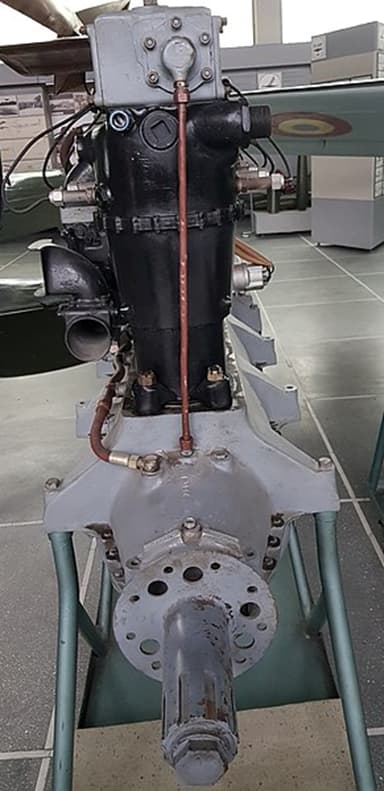
https://en.wikipedia.org/wiki/Siddeley_Puma#/media/File:Siddeley-Puma_MilMusBuc_20200305_1.jpg
British ANEC I and II Ultra-Light Private Aircraft
The ANEC I and II were echoes of humankind’s original dream, of flying alone in the sky among the birds. They also had several innovative features, despite aircraft manufacture being generally in the hands of established companies. William Shackleton, son of explorer Earnest first flew the prototype on August 21, 1923.
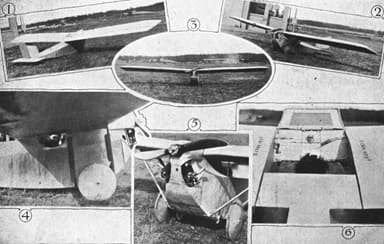
http://aviadejavu.ru/Site/Crafts/Craft33385.htm
The ANEC I and II were amongst the earliest, ultralight, wooden, strut braced high-wing monoplanes. They were also the first aircraft that flew in the United Kingdom with inverted engines. This design allows for larger propellers, and lower centers of gravity by positioning the heavy cast iron cylinders below.
William Shackleton designed the prototype to meet the standards of the 1923 Lympne light aircraft trials ,which limited engine capacity to 45 cubic inches. He shared half the prize with an English Electric Wren pilot. Later, he reached an altitude of 14,000 ft. in ANEC I
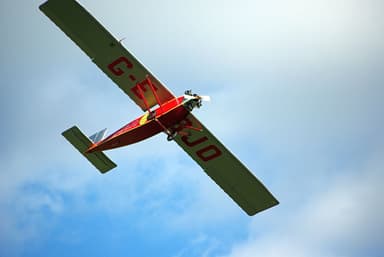
https://en.wikipedia.org/wiki/File:ANEC_II.jpg
The later specification of the ANEC 1 was as follows:
- Length 15 ft, height 3 ft, wing span 32.5 ft, wing area 145 sq ft
- Empty weight 290 lb, gross weight 470 lb, crew one
- Blackburne Tomtit 2-cylinder air-cooled inverted V piston engine, 16 hp
- Max speed 74 mph, stall 32 mph, 3,000 feet in eight minutes
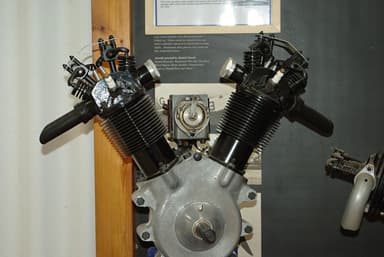
https://en.wikipedia.org/wiki/Blackburne_Tomtit#/media/File:Backburne_Tomtit.JPG
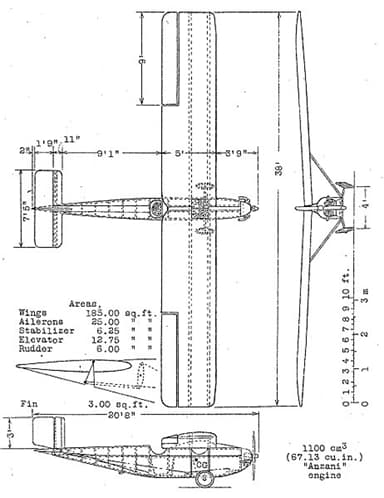
https://en.wikipedia.org/wiki/File:ANEC_II_3-view_NACA-TM-289.jpg
SEPTEMBER 1923
A French Nieuport-Delage NiD 40R sets a new world altitude record of 35,239 feet.
United States Marine Corps Lieutenant Lawson H. Sanderson sets a new world airspeed record of 238 mph in a Navy-Wright NW.
OCTOBER 1923
French pilot Joseph Sadi-Lecointe sets a new world altitude record of 36,565 feet flying a Nieuport-Delage NiD 40R. The record will stand until 1927.
British Handley Page Hyderabad Twin-Engine Heavy Bomber
The Handley Page Hyderabad H.P.24 was a large, twin-engine biplane heavy bomber that served the Royal Air Force from 1925 to 1933. The prototype first flew on October 23, 1923, whereafter Handley Page delivered a total of 39 aircraft to four different Royal Air Force squadrons.
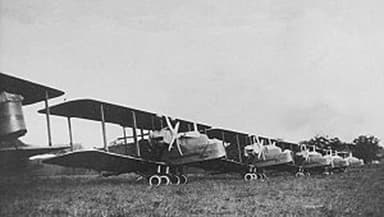
https://en.wikipedia.org/wiki/Handley_Page_Hyderabad
The Hyderabad was a development of the Handley Page W.8 airliner, and intended as a replacement for the Vickers Vimy approaching the end of useful value. It was one of the last all-wooden, three-bay biplanes. However, it was one of the first large aircraft to be fitted with Handley Page leading edge slats, giving good lateral stability.
The Royal Airforce initially purchased one for evaluation against the Vickers Virginia. Deliveries were slow against a confirmed order, and accidental losses were high. Two squadrons were subsequently re-equipped with the Handley Page Hinaidi, an all-metal version of the Hyderabad in 1931.
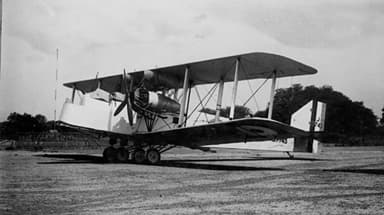
https://commons.wikimedia.org/wiki/File:Handley_Page_Hinaidi.jpg
The specification of the original Hyderabad was as follows:
- Length 59 ft, height 16.5 ft, wing span 75 ft, wing area 1,471 sq ft
- Empty weight 8,910 lb, gross weight 13,590 lb, crew four
- Two Napier Lion V (or VA W-12) water-cooled piston engines, 500 hp each
- Max speed 109 mph, range 500 mi, ceiling 14,000 ft, climb 800 ft / min
- 1,100 pound bomb load carried externally
- Three × 0.303 inch Lewis guns in nose, dorsal and ventral positions
British de Havilland DH.53 Humming Bird Ultra-Light Monoplane
The de Havilland DH.53 Humming Bird was a single-seat, single-engine, low-wing monoplane light aircraft that first flew in October 1923. The company originally built it as an entrant to the Daily Mail Light Aeroplane Competition of that year. However, a few also found a niche in the Royal Airforce.

https://commons.wikimedia.org/wiki/File:DHHummingB.jpg
The Humming Bird failed to win any prizes at the Lympne Airport competition venue. It nonetheless impressed sufficiently to attract the interest of Britain’s Air Ministry. Officials ordered eight in1924, as communications and training aircraft for the Royal Air Force.
The first six ultra-light aircraft raced against each other at the 1925 display at RAF Hendon. The final two were later used for ‘parasite aircraft’ trials, being launched from below the R.33 airship. All eight were sold in 1927, and ended their days as recreational aircraft.
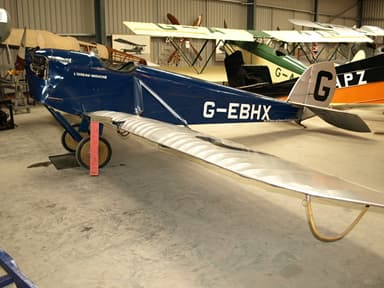
https://en.wikipedia.org/wiki/File:DH53.JPG
The specification of the de Havilland DH.53 Humming Bird was as follows:
- Length 19.5 ft, height 7.5 ft, wing span 30 ft, wing area 125 sq ft
- Empty weight 326 lb, gross weight 565 lb, crew one
- Blackburne Tomtit V-2 inverted air-cooled piston engine, 26 hp
- Max 75 mph, cruise 60 mph, range 130 mi, ceiling 15,000 ft, 225 ft / min
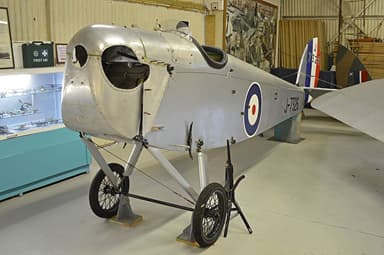
https://commons.wikimedia.org/wiki/File:De_Havilland_DH53_Humming_Bird_%E2%80%98J7326%E2%80%99_(G-EBQP)_(17008728536).jpg
British Vickers Viget Single-Seat Biplane with Folding Wings
The Vickers Viget was built for the 1923 Lympne Light Aeroplane Trials for ‘motorized gliders’, organized by the Royal Aero Club. Their hope was to encourage development of economical private aviation, and so they specified a maximum engine size of 45 cubic inches. The wings also folded in terms of the competition rules.

https://commons.wikimedia.org/wiki/File:Vickers_Viget.jpg
The small, single-bay biplane had constant chord wings with no stagger, and a dihedral curve on the lower plane only. Full span ailerons were fitted on both upper and lower wings. The lower wing was mounted on the bottom of the fuselage, and the upper one well clear of the head of the pilot who sat under it in an open cockpit.
The Vickers Viget flew well enough, but not well enough to win prizes. It ended its flight in a field six miles from the venue after a rocker arm failed.
The pilot, Stan Cockerell decided to push the light aircraft home, but stopped at a pub on the way. After he downed his drink and returned to his aircraft, he found a small crowd gathered expecting a Punch and Judy show. History does not record what happened next. They must have found unusual uses for surplus aircraft in those days!
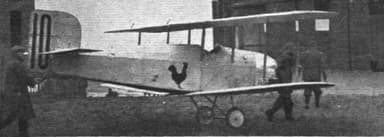
https://commons.wikimedia.org/wiki/File:Vickers_Viget_on_the_ground.png
The specification of the Vickers Viget was as follows:
- Length 17.5 ft, wing span 25 ft, wing area 200 square feet
- Empty weight 390 lb, gross weight 550 lb, crew one
- Douglas 2 cylinder horizontally opposed engine, max speed 58 mph

https://www.douglasmotorcycles.net/index.php?topic=1849.0
November 1923
U.S. Navy Lieutenant H. J. Rowe sets a new world airspeed record of 259 mph flying a Curtiss R2C-1. U.S. Navy Lieutenant Alford J. Williams later takes the same aircraft to 266 mph.
DECEMBER 1923
Japanese Mitsubishi 1MF Biplane Carrier Fighter Aircraft
The Mitsubishi 1MF biplane entered service with the Imperial Japanese Navy. It was the brainchild of British aircraft designer Herbert Smith, who assisted with work at Mitsubishi Internal Combustion.
The 1MF was a single-seat, single-bay biplane with unequal-span wings and all-wooden construction. It was fitted with claw-type arrestor gear for use with British-style fore-and-aft arrestor cables on aircraft carriers. Over 130 aircraft were built through to 1928.
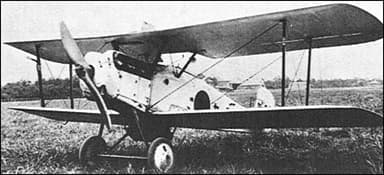
https://en.wikipedia.org/wiki/File:Mitsubishi_1MF3A.jpg
The Mitsubishi 1MF was a successful aircraft. It proved to be a tough, reliable machine, and operated from Akagi and Kaga carriers when they entered service in 1927 and 1928, as well as from Hōshō. It continued in service through to 1930, when the Nakajima A1N carrier fighter replaced it.
The specification of the Mitsubishi 1MF3 version was as follows:
- Length 22.5 ft, height 10 ft, wing span 28 ft
- Empty weight 2,072 lb, gross weight 2,822 lb, crew one
- Mitsubishi Hi V-8 water-cooled piston engine, 300 hp
- Max speed 132 mph, endurance 2.5 hrs, ceiling 23,000 ft, 9,843 ft 10 min
- Armament: Two 0.303 inch machine guns.
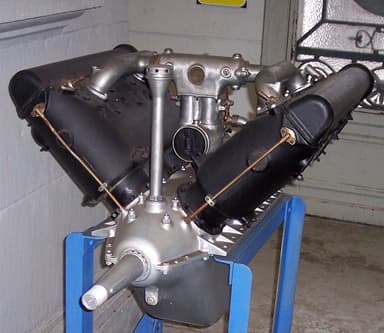
https://en.wikipedia.org/wiki/Hispano-Suiza_8#/media/File:Hispano_Suiza_8_A_Brussel.jpg





